Celso de Melo
VAMOS: A Hierarchical Vision-Language-Action Model for Capability-Modulated and Steerable Navigation
Oct 23, 2025Abstract:A fundamental challenge in robot navigation lies in learning policies that generalize across diverse environments while conforming to the unique physical constraints and capabilities of a specific embodiment (e.g., quadrupeds can walk up stairs, but rovers cannot). We propose VAMOS, a hierarchical VLA that decouples semantic planning from embodiment grounding: a generalist planner learns from diverse, open-world data, while a specialist affordance model learns the robot's physical constraints and capabilities in safe, low-cost simulation. We enabled this separation by carefully designing an interface that lets a high-level planner propose candidate paths directly in image space that the affordance model then evaluates and re-ranks. Our real-world experiments show that VAMOS achieves higher success rates in both indoor and complex outdoor navigation than state-of-the-art model-based and end-to-end learning methods. We also show that our hierarchical design enables cross-embodied navigation across legged and wheeled robots and is easily steerable using natural language. Real-world ablations confirm that the specialist model is key to embodiment grounding, enabling a single high-level planner to be deployed across physically distinct wheeled and legged robots. Finally, this model significantly enhances single-robot reliability, achieving 3X higher success rates by rejecting physically infeasible plans. Website: https://vamos-vla.github.io/
Adapting Vehicle Detectors for Aerial Imagery to Unseen Domains with Weak Supervision
Jul 28, 2025Abstract:Detecting vehicles in aerial imagery is a critical task with applications in traffic monitoring, urban planning, and defense intelligence. Deep learning methods have provided state-of-the-art (SOTA) results for this application. However, a significant challenge arises when models trained on data from one geographic region fail to generalize effectively to other areas. Variability in factors such as environmental conditions, urban layouts, road networks, vehicle types, and image acquisition parameters (e.g., resolution, lighting, and angle) leads to domain shifts that degrade model performance. This paper proposes a novel method that uses generative AI to synthesize high-quality aerial images and their labels, improving detector training through data augmentation. Our key contribution is the development of a multi-stage, multi-modal knowledge transfer framework utilizing fine-tuned latent diffusion models (LDMs) to mitigate the distribution gap between the source and target environments. Extensive experiments across diverse aerial imagery domains show consistent performance improvements in AP50 over supervised learning on source domain data, weakly supervised adaptation methods, unsupervised domain adaptation methods, and open-set object detectors by 4-23%, 6-10%, 7-40%, and more than 50%, respectively. Furthermore, we introduce two newly annotated aerial datasets from New Zealand and Utah to support further research in this field. Project page is available at: https://humansensinglab.github.io/AGenDA
SpatialReasoner: Towards Explicit and Generalizable 3D Spatial Reasoning
Apr 28, 2025



Abstract:Recent studies in 3D spatial reasoning explore data-driven approaches and achieve enhanced spatial reasoning performance with reinforcement learning (RL). However, these methods typically perform spatial reasoning in an implicit manner, and it remains underexplored whether the acquired 3D knowledge generalizes to unseen question types at any stage of the training. In this work we introduce SpatialReasoner, a novel large vision-language model (LVLM) that address 3D spatial reasoning with explicit 3D representations shared between stages -- 3D perception, computation, and reasoning. Explicit 3D representations provide a coherent interface that supports advanced 3D spatial reasoning and enable us to study the factual errors made by LVLMs. Results show that our SpatialReasoner achieve improved performance on a variety of spatial reasoning benchmarks and generalizes better when evaluating on novel 3D spatial reasoning questions. Our study bridges the 3D parsing capabilities of prior visual foundation models with the powerful reasoning abilities of large language models, opening new directions for 3D spatial reasoning.
F-ViTA: Foundation Model Guided Visible to Thermal Translation
Apr 03, 2025



Abstract:Thermal imaging is crucial for scene understanding, particularly in low-light and nighttime conditions. However, collecting large thermal datasets is costly and labor-intensive due to the specialized equipment required for infrared image capture. To address this challenge, researchers have explored visible-to-thermal image translation. Most existing methods rely on Generative Adversarial Networks (GANs) or Diffusion Models (DMs), treating the task as a style transfer problem. As a result, these approaches attempt to learn both the modality distribution shift and underlying physical principles from limited training data. In this paper, we propose F-ViTA, a novel approach that leverages the general world knowledge embedded in foundation models to guide the diffusion process for improved translation. Specifically, we condition an InstructPix2Pix Diffusion Model with zero-shot masks and labels from foundation models such as SAM and Grounded DINO. This allows the model to learn meaningful correlations between scene objects and their thermal signatures in infrared imagery. Extensive experiments on five public datasets demonstrate that F-ViTA outperforms state-of-the-art (SOTA) methods. Furthermore, our model generalizes well to out-of-distribution (OOD) scenarios and can generate Long-Wave Infrared (LWIR), Mid-Wave Infrared (MWIR), and Near-Infrared (NIR) translations from the same visible image. Code: https://github.com/JayParanjape/F-ViTA/tree/master.
Texture- and Shape-based Adversarial Attacks for Vehicle Detection in Synthetic Overhead Imagery
Dec 20, 2024



Abstract:Detecting vehicles in aerial images can be very challenging due to complex backgrounds, small resolution, shadows, and occlusions. Despite the effectiveness of SOTA detectors such as YOLO, they remain vulnerable to adversarial attacks (AAs), compromising their reliability. Traditional AA strategies often overlook the practical constraints of physical implementation, focusing solely on attack performance. Our work addresses this issue by proposing practical implementation constraints for AA in texture and/or shape. These constraints include pixelation, masking, limiting the color palette of the textures, and constraining the shape modifications. We evaluated the proposed constraints through extensive experiments using three widely used object detector architectures, and compared them to previous works. The results demonstrate the effectiveness of our solutions and reveal a trade-off between practicality and performance. Additionally, we introduce a labeled dataset of overhead images featuring vehicles of various categories. We will make the code/dataset public upon paper acceptance.
A Mamba-based Siamese Network for Remote Sensing Change Detection
Jul 08, 2024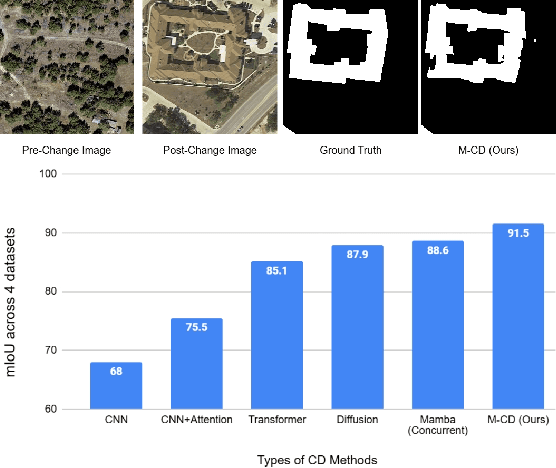
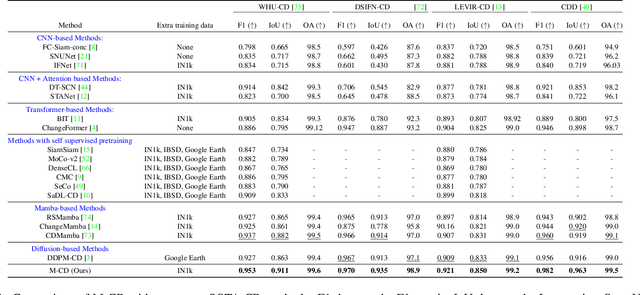


Abstract:Change detection in remote sensing images is an essential tool for analyzing a region at different times. It finds varied applications in monitoring environmental changes, man-made changes as well as corresponding decision-making and prediction of future trends. Deep learning methods like Convolutional Neural Networks (CNNs) and Transformers have achieved remarkable success in detecting significant changes, given two images at different times. In this paper, we propose a Mamba-based Change Detector (M-CD) that segments out the regions of interest even better. Mamba-based architectures demonstrate linear-time training capabilities and an improved receptive field over transformers. Our experiments on four widely used change detection datasets demonstrate significant improvements over existing state-of-the-art (SOTA) methods. Our code and pre-trained models are available at https://github.com/JayParanjape/M-CD
WeatherProof: Leveraging Language Guidance for Semantic Segmentation in Adverse Weather
Mar 21, 2024
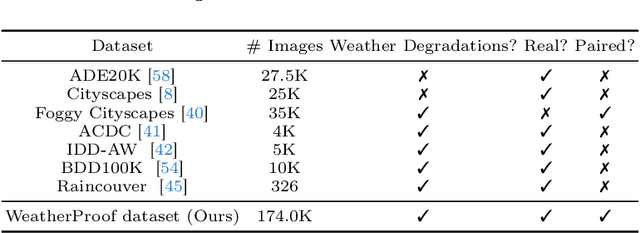


Abstract:We propose a method to infer semantic segmentation maps from images captured under adverse weather conditions. We begin by examining existing models on images degraded by weather conditions such as rain, fog, or snow, and found that they exhibit a large performance drop as compared to those captured under clear weather. To control for changes in scene structures, we propose WeatherProof, the first semantic segmentation dataset with accurate clear and adverse weather image pairs that share an underlying scene. Through this dataset, we analyze the error modes in existing models and found that they were sensitive to the highly complex combination of different weather effects induced on the image during capture. To improve robustness, we propose a way to use language as guidance by identifying contributions of adverse weather conditions and injecting that as "side information". Models trained using our language guidance exhibit performance gains by up to 10.2% in mIoU on WeatherProof, up to 8.44% in mIoU on the widely used ACDC dataset compared to standard training techniques, and up to 6.21% in mIoU on the ACDC dataset as compared to previous SOTA methods.
Towards Ground Truth for Single Image Deraining
Jun 22, 2022
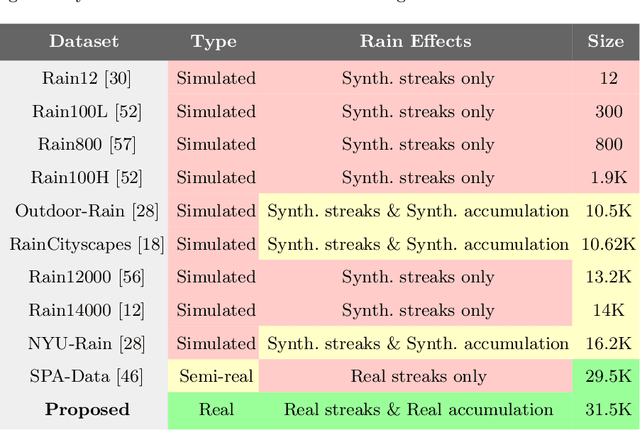

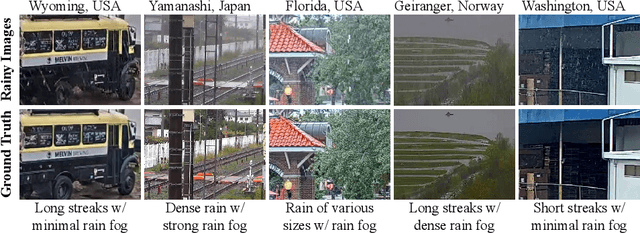
Abstract:We propose a large-scale dataset of real-world rainy and clean image pairs and a method to remove degradations, induced by rain streaks and rain accumulation, from the image. As there exists no real-world dataset for deraining, current state-of-the-art methods rely on synthetic data and thus are limited by the sim2real domain gap; moreover, rigorous evaluation remains a challenge due to the absence of a real paired dataset. We fill this gap by collecting the first real paired deraining dataset through meticulous control of non-rain variations. Our dataset enables paired training and quantitative evaluation for diverse real-world rain phenomena (e.g. rain streaks and rain accumulation). To learn a representation invariant to rain phenomena, we propose a deep neural network that reconstructs the underlying scene by minimizing a rain-invariant loss between rainy and clean images. Extensive experiments demonstrate that the proposed dataset benefits existing derainers, and our model can outperform the state-of-the-art deraining methods on real rainy images under various conditions.
 Add to Chrome
Add to Chrome Add to Firefox
Add to Firefox Add to Edge
Add to Edge